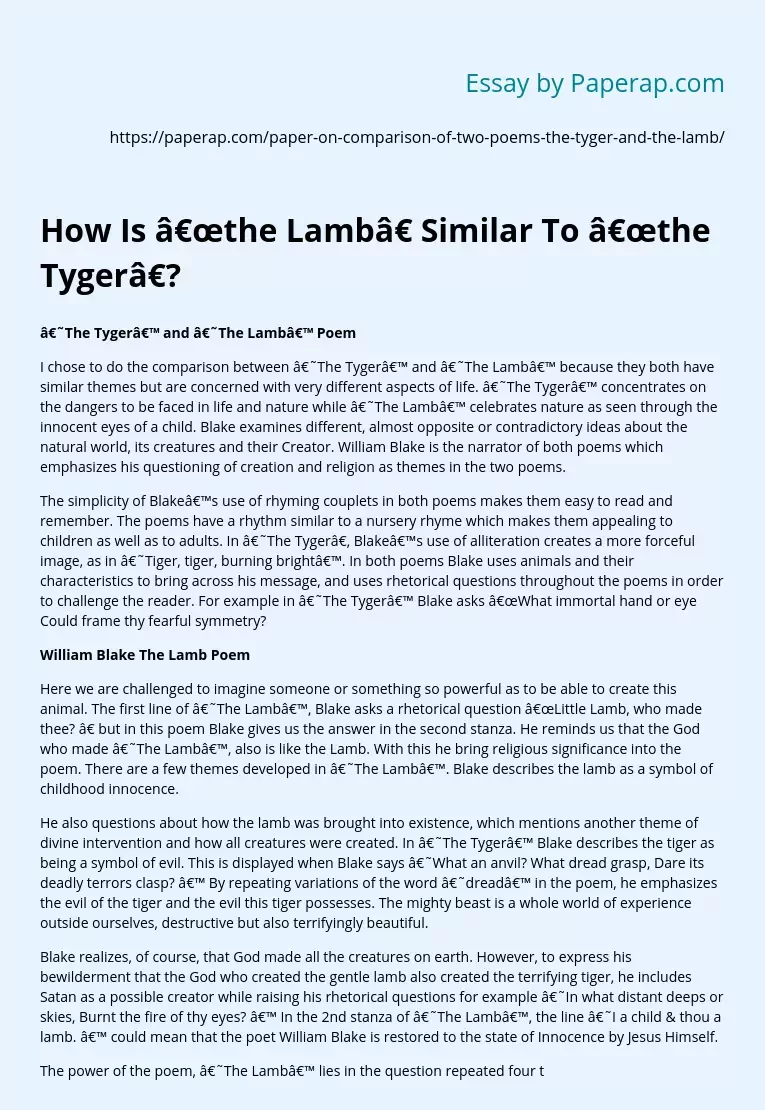How Is “the Lamb” Similar To “the Tyger”?
‘The Tyger’ and ‘The Lamb’ Poem
I chose to do the comparison between ‘The Tyger’ and ‘The Lamb’ because they both have similar themes but are concerned with very different aspects of life. ‘The Tyger’ concentrates on the dangers to be faced in life and nature while ‘The Lamb’ celebrates nature as seen through the innocent eyes of a child. Blake examines different, almost opposite or contradictory ideas about the natural world, its creatures and their Creator. William Blake is the narrator of both poems which emphasizes his questioning of creation and religion as themes in the two poems.
The simplicity of Blake’s use of rhyming couplets in both poems makes them easy to read and remember. The poems have a rhythm similar to a nursery rhyme which makes them appealing to children as well as to adults. In ‘The Tyger”, Blake’s use of alliteration creates a more forceful image, as in ‘Tiger, tiger, burning bright’. In both poems Blake uses animals and their characteristics to bring across his message, and uses rhetorical questions throughout the poems in order to challenge the reader.
For example in ‘The Tyger’ Blake asks “What immortal hand or eye Could frame thy fearful symmetry?
William Blake The Lamb Poem
Here we are challenged to imagine someone or something so powerful as to be able to create this animal. The first line of ‘The Lamb’, Blake asks a rhetorical question “Little Lamb, who made thee? ” but in this poem Blake gives us the answer in the second stanza.
He reminds us that the God who made ‘The Lamb’, also is like the Lamb. With this he bring religious significance into the poem. There are a few themes developed in ‘The Lamb’. Blake describes the lamb as a symbol of childhood innocence.
He also questions about how the lamb was brought into existence, which mentions another theme of divine intervention and how all creatures were created. In ‘The Tyger’ Blake describes the tiger as being a symbol of evil. This is displayed when Blake says ‘What an anvil? What dread grasp, Dare its deadly terrors clasp? ’ By repeating variations of the word ‘dread’ in the poem, he emphasizes the evil of the tiger and the evil this tiger possesses. The mighty beast is a whole world of experience outside ourselves, destructive but also terrifyingly beautiful.
Blake realizes, of course, that God made all the creatures on earth. However, to express his bewilderment that the God who created the gentle lamb also created the terrifying tiger, he includes Satan as a possible creator while raising his rhetorical questions for example ‘In what distant deeps or skies, Burnt the fire of thy eyes? ’ In the 2nd stanza of ‘The Lamb’, the line ‘I a child & thou a lamb. ’ could mean that the poet William Blake is restored to the state of Innocence by Jesus Himself.
The power of the poem, ‘The Lamb’ lies in the question repeated four times: ‘Who made thee? and Blake invites us to ask this profound and fundamental question of ourselves. The repetition of this question could also imply that Blake doubts that he who created innocence symbolized by the lamb would also create an evil portrayed by the tiger. ‘The Tyger’ is ruled by symmetry: symmetry between stanzas, between lines and within lines. For this reason, one of the details that leaps out at us immediately is the lack of symmetry between the first and last stanzas, where a single word ‘could’ in stanza 1 is changed to ‘dare’ in stanza 6.
Compare ‘What immortal hand or eye could frame thy fearful symmetry? ’ with ‘What immortal hand or eye dare frame thy fearful symmetry? ’ The first question asks if there is any power that has the ability to create such a terrible entity as the tiger; the second suggests that even if there were a power able to create the tiger, would it have the nerve and the courage to create such an awesome beast. His feelings intensify from awe to disbelief towards the end of the poem.
Both poems contain many similarities according to their themes. The Tiger’ was taken from a collection of poems by Blake called The Songs of Experience. These poems focus on evil and the importance of understanding the evil around in the hope of attaining a state of innocence. ‘The Lamb’ is an extract from a collection of poems entitled ‘Songs of Innocence’ that suggests by recapturing the imagination and wonderment of childhood, we could achieve the goal of self awareness. ‘The Lamb’ is an emblem of innocence corresponding to ‘The Tyger’ as the emblem of experience.
Blake provides no answer. His mission is to reflect reality in arresting images. A poet’s first purpose is to present the world a language that stimulates the senses, and not to force an opinion or moralize. Nevertheless, the poem does stir the reader to deep thought. Here is the tiger, fierce and brutal in its quest for sustenance; there is the lamb, meek and gentle in its quest for survival. Is it possible that the same God who made the lamb also made the tiger? Or was the tiger the devil’s work?
How Is “the Lamb” Similar To “the Tyger”?. (2019, Dec 05). Retrieved from https://paperap.com/paper-on-comparison-of-two-poems-the-tyger-and-the-lamb/

